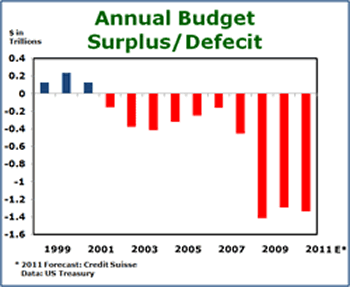U.S. Interest Rates Surge as Fed, Congress Crush Debtholders
Interest-Rates / US Bonds Dec 10, 2010 - 08:35 AM GMTBy: Mike_Larson
 Washington, 0. The bond market, 1.
Washington, 0. The bond market, 1.
That’s the score folks, in case you haven’t been keeping track. The Federal Reserve Chairman said his $600 billion “QE2″ program would lower interest rates. Instead, rates have done nothing but rise since investors got wind of the Treasury buying plan.
Then this week, Republicans in Congress — and the Obama administration — decided to kick Treasury holders while they’re down. They announced plans to cut estate taxes, lower payroll taxes, extend President Bush’s tax cuts for even the wealthiest citizens, and extend unemployment benefits for jobless Americans.
The catch? There’s no plan whatsoever to pay for any of it! The deal makes a total mockery of all that highfalutin language from the National Commission on Fiscal Responsibility and Reform.
Tallying Up the Losses
The bond market’s reaction has been swift and severe. Treasury bond prices plunged more than 2 points on Tuesday and another point-and-a-half the next day. That sent them to a six-month low.
The yield on the 10-year Treasury Note surged 21 basis points on Tuesday and another 15 on Wednesday. That brings its cumulative rise since October to 89 basis points!
What about shorter-term Treasuries? No solace there. The yield on the 5-year note has almost doubled — from 1.02 percent to 1.87 percent!
|
Municipals? If you bought these overvalued securities earlier this year when I said to avoid them, you’ve gotten hammered. Some muni bond funds have lost 7 percent, 8 percent, or 9 percent of their value in just a couple months.
Or what about STRIPS — bond market investments that are among the most sensitive to changes in interest rates? Hold on to your hats! The Vanguard Extended Duration Treasury ETF (EDV), which tracks the value of these investments, has plunged more than 21 percent since late August.
Budget Deficit Exploding as Fiscal Sanity Sorely Lacking
I’ve already discussed how the Fed’s plan to support bond prices has been a dismal failure. So there’s no need to bang that drum too loudly right now. The new selling catalyst this week was the budget-busting bundle of tax and benefit goodies The New York Times dubbed a “back-door stimulus plan.”
Politicians on both sides of the aisle have paid a lot of lip service to cutting deficits. They’ve talked of the need for fiscal restraint. Some have pointed to the European debt crisis as a preview of what could happen here if we don’t get our house in order.
But what they’re SAYING and what they’re DOING are too completely different things. The latest package being discussed in Washington will likely cost more than $900 billion over the next two years. That’s on par with the cost of the previous “official” stimulus plan.
|
We don’t have the money, of course; so the budget deficit is going to explode once again. Credit Suisse now estimates the deficit will come in at a whopping $1.34 trillion in fiscal 2011. That’s after a $1.29 trillion deficit in 2010 and $1.42 trillion in red ink in 2009.
As the chart to the right clearly shows, Washington spending is out of control!
We were able to get away with this for a while. But now bond investors are demanding their pound of flesh. The cost of borrowing is climbing here in the U.S., just as it already surged in heavily indebted European nations.
My strategy? Continue to avoid long-term Treasuries during the “plunge” phase of this move. Or consider buying investments that rise in value as bonds fall.
Then once rates rise to reasonable levels, look to tentatively, selectively add exposure to fixed-income investments. That way you’ll lock in much juicier yields for the future.
Until next time,
Mike
P.S. This week on Money and Markets TV, we checked in on the health of the U.S. economy, and offered our prognosis for the pace of recovery in 2011. And I gave viewers my opinion on whether economic growth will speed up next year, plus a perspective on last week’s disappointing employment report.
If you missed last night’s episode of Money and Markets TV — or would like to see it again at your convenience — it’s now available at www.weissmoneynetwork.com.
This investment news is brought to you by Money and Markets. Money and Markets is a free daily investment newsletter from Martin D. Weiss and Weiss Research analysts offering the latest investing news and financial insights for the stock market, including tips and advice on investing in gold, energy and oil. Dr. Weiss is a leader in the fields of investing, interest rates, financial safety and economic forecasting. To view archives or subscribe, visit http://www.moneyandmarkets.com.
© 2005-2022 http://www.MarketOracle.co.uk - The Market Oracle is a FREE Daily Financial Markets Analysis & Forecasting online publication.





